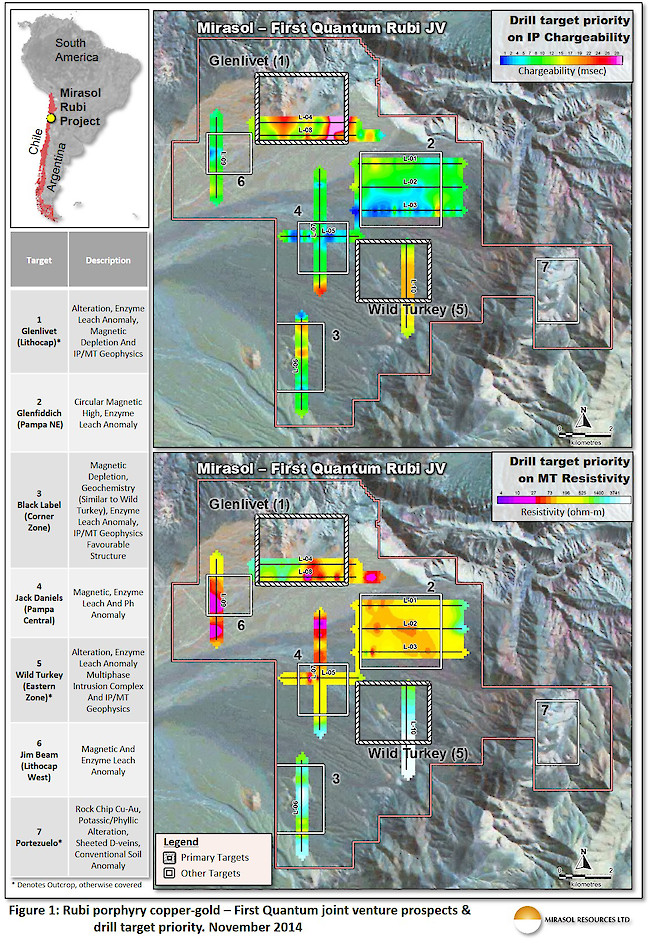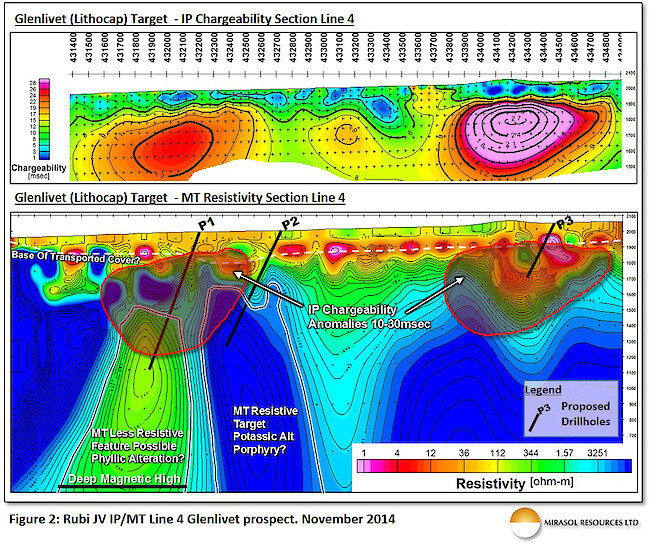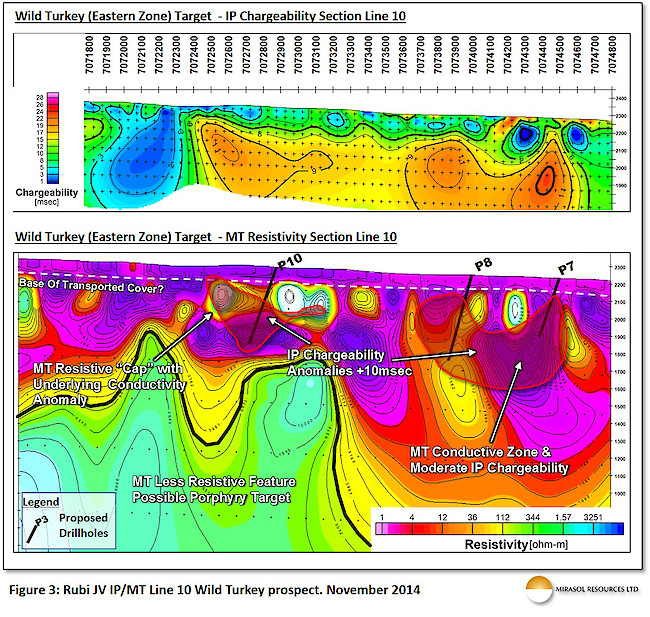Mirasol reports geophysical results and the start of drilling at the Rubi JV with First Quantum in northern Chile
VANCOUVER, BC, November 10th, 2014 – Mirasol Resources Ltd. (TSX-V: MRZ, Frankfurt: M8R)
- IP and MT geophysical surveys completed; anomalies detected in two prospects.
- Integrated target selection is complete for this phase of drilling.
- Drill permit granted late August; and drill contract signed.
- Drilling of phase 1 program commenced mid-October, 2014.
Mirasol is pleased to report that First Quantum Minerals (First Quantum) has commenced the Phase I drilling campaign at the Rubi JV porphyry copper – gold project in the El Salvador district in northern Chile. This program will focus on priority-ranked targets (Figure 1) in the Glenlivet (Lithocap) and Wild Turkey (Eastern Zone) prospects, and could include up to eleven holes of between 500 to 1,000 m depth, totaling up to 5,000 m. If all planned holes are drilled this program may take up to 3 months to complete. The drilling will be carried out by Geotec Boyles, a Chilean company with over 30 years experience in the sometimes challenging conditions of the Atacama region. The program will use a multi-purpose rig which will allow a combination of reverse circulation (RC), and diamond core (DDH) drilling through the diverse post-mineral cover over the target zones.
Prior to commencing this drill program, First Quantum completed a 37 line-km program of IP electrical and Magneto Telluric1 (MT) geophysics comprising 10 lines over six prospect areas (Figure 1); geophysics has not yet been carried out over the Portezuelo target on the eastern side of the property. This geophysics program represents the culmination of an extensive 12-month pre-drill exploration program, adding to the JV datasets that include a 2,460 line-km helicopter magnetic survey, extensive property-wide soil and gravity surveys, as well as geological mapping, rock chip sampling and alteration mineral assemblage mapping with a hand-held infrared spectrometer.
Integrated analysis of these JV datasets by First Quantum has identified a series of targets for testing during the Phase I drill program. Drilling will focus on target areas where a combination of outcropping alteration, rock chip or soil anomalies and geophysical features outlined a series of covered targets that warrant testing for porphyry copper mineralization.
At Glenlivet, the surface expression of the prospect is in-part defined by a large outcropping advanced argillic alteration zone (a lithocap) that may extend to the south and east for an unknown distance under gravel cover. This alteration may represent the high-level expressions of a porphyry-related alteration system. Rock chip sampling has returned strongly anomalous copper, gold and molybdenum in narrow structures at several areas around the lithocap. The recently completed IP geophysics at Glenlivet (Figure 2) has outlined two moderate intensity (+10 to 30 msec) IP chargeability anomalies up to 1 km in length, beneath the southern edge of the lithocap. The MT survey at Glenlivet has mapped “finger”-like resistive bodies underlying the IP chargeability features. The geometry of the geophysical anomalies at Glenlivet show some similarities to the geophysical responses over the El Salvador and Inca de Oro porphyry2 (see Figure 2) where MT resistivity and IP chargeability have been used to map mineralized zones in these porphyry systems.
The Wild Turkey prospect is largely gravel-covered, however small outcrops through the cover show granodiorite with some limonite and localized copper oxides and some porphyry-style veins and breccias. These styles of alteration can occur on the margin of a porphyry system. An Enzyme Leach3 geochemical soil survey over the prospect has highlighted a strong multi-element anomaly over 1 km in length in the gravel cover that could suggest mineralization present in the underlying basement. The Wild Turkey geophysical line does not test this soil anomaly, passing 500 m to the east. However the IP survey (Figure 3) has mapped two low order chargeable (+10 to 15 msec) anomalies associated with MT features in the basement. A combination of Enzyme Leach soil anomalies and IP / MT geophysical anomalies have been targeted for drill testing at Wild Turkey.
This drill program will provide a first pass test of a range of covered targets that are supported by coincident geophysical / geochemical and geological information at two of the key prospects at the Rubi Project. Mirasol’s management are pleased that First Quantum have advanced the project to rapidly test these targets.
Stephen Nano, President and CEO is the Qualified Person under NI 43-101 who has prepared and approves the technical content of this news release.
For further information, contact:
Stephen Nano
President and CEO
Tel: (604) 602-9989: Fax:(604) 609-9946
Email: contact@mirasolresources.com
Website: www.mirasolresources.com
Quality Assurance/Quality Control:
First Quantum Minerals operates the Rubi Joint Venture and generated the geological, geophysical and geochemical information reported to Mirasol Resources. First Quantum uses industry accepted procedures for the collection and analysis of this information including a formal quality assurance and quality control (QA/QC) program and ISO 9001:2000-accredited assay laboratories for geochemical analysis. Mirasol has performed an independent analysis of the information and reports provided by First Quantum. Stephen Nano has reviewed the data and prepared this news release, and is a qualified person as defined by National Instrument 43-101.
Neither the TSX Venture Exchange nor its Regulation Services Provider (as that term is defined in the policies of the TSX Venture Exchange) accepts responsibility for the adequacy or accuracy of this release.
Additional Explanatory notes
1The Magneto Telluric geophysical technique measures variations in resistivity and conductivity of an area of rock being surveyed using the natural magnetic fields and electrical currents generated by the planet as a power source, rather than using an induced current from a manmade generator as with the IP technique. MT does not map chargeability responses, but has an advantage over IP in that it can map resistive / conductive features to depths in excess of 1 km in areas where traditional IP can be impeded by conductive cover sequences.
2Inca de Oro porphyry: Porphyry copper-gold project (an incorporated joint venture with PanAust and Codelco) located approximately 40 km to the southwest of Rubi. The project has a current resource (supergene and primary) of 389 Mt at 0.39 % Cu and 0.1 g/t Au (PanAust 2014 Mineral Resource and Ore Reserve Statements).
3Enzyme partial leach soil sampling: Actlabs Enzyme Leach SM used at the Rubi Project is a partial leach technique that selectively extracts elements from amorphous manganese oxide coatings on soil materials. Under the right circumstances, these elements potentially derived from underlying concealed mineralization are transported through the soil profile and concentrate in the oxide coatings. The Enzyme Leach soil technique has been successfully used to detect soil or gravel-covered mineralization by other companies in Chile and at other locations around the world.


